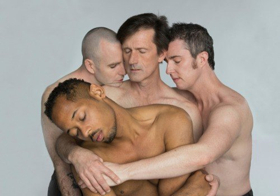BWW Dance Review: Sean Dorsey's THE MISSING GENERATION, June 20, 2018.

There have been times in my dance going career when I've seen things I desperately wanted to embrace. Yet, for all my feelings, I felt that there was a gap between my critical acumen and what was being presented on stage. That is very much my reaction to the Sean Dorsey Dance production of The Missing Generation. What I wanted to love was not within my grasp.
I am a gay man; I lived through AIDS, political activism, free love, and just about anything else. So what's my problem? It's just that with all my own baggage, my memories of those I loved and lost, I have to make a value judgement. I would love to heap praise, but I'm prevented by critical thinking.
Such is the curse of the aching, despondent brain!!!!
The Missing Generation is Sean Dorsey's dance poem to the gay, bisexual and transgendered AIDS generation population, one that perished and survived the long, epic medical and political battles of the 1980s and early 1990s. A transgendered, queer choreographer, dancer, writer and longtime trans activist, Dorsey spent more than two years on this project, interviewing survivors, working with a team of four composers to create original music and then spending over 600 hours editing, drafting and recording the final soundscore. That anyone could give so unstintingly of his time and creative spirit is in itself a testament to Dorsey's commitment and passion for this project. Would that we all had this spirit!
Words! They look beautiful on paper and their sound can be poetry that moves us. And dance. A body in flight, in motion, taking wing. But words and dance together? That constitutes a problem, especially here, since the words, for all their passion, are not well recorded and at times are totally incomprehensible. So why even include them? Wasn't someone listening to the voices on the tape and making suggestions on how they could be rectified for the production?
And the dance itself? Perhaps if this had been a dance meditation on AIDS, a fantasia on the epidemic and a tribute to those who survived it, it could have produced a stronger response within me. I wanted to be aroused and impassioned, to cry, to bang my hands and clap when the dance was over.
It was just these two great art forms that had trouble fusing. I don't think that either one was at the service of the other. The words could not direct the choreography and the choreography by itself seemed disjointed, unsure of how it should proceed. Certainly one can understand Mr. Dorsey's love for this work, but even love needs some clear-sighted and tough-minded decisions on how to make it flow more smoothly for an audience. I don't think Mr. Dorsey objectified his approach very clearly. He wanted to tell us everything, but sometimes everything needs editing.
Again, my perception.
The lighting by Clyde Sheets was first rate, as were the performances of Sean Dorsey, Brian Fisher, Arvejon Jones and Will Woodward. The four dancers constituted a wonderfully diverse array of characters from an era that many, including myself, remember as one of the most terrifying times of their lives. And for those who were not there, it is important to remember and realize just how arduous the journey has been. We may think we've arrived, but there's always more just in front of us.
The Joyce is to be congratulated for presenting Mr. Dorsey, the first transgendered artist, to appear on its stage. We will hopefully see more of him and his company in the near future. They have a great history to impart; I look forward to learning more and acknowledging his wisdom and theatrical intelligence.
Comments
.png)
|
.png)
|
Videos

